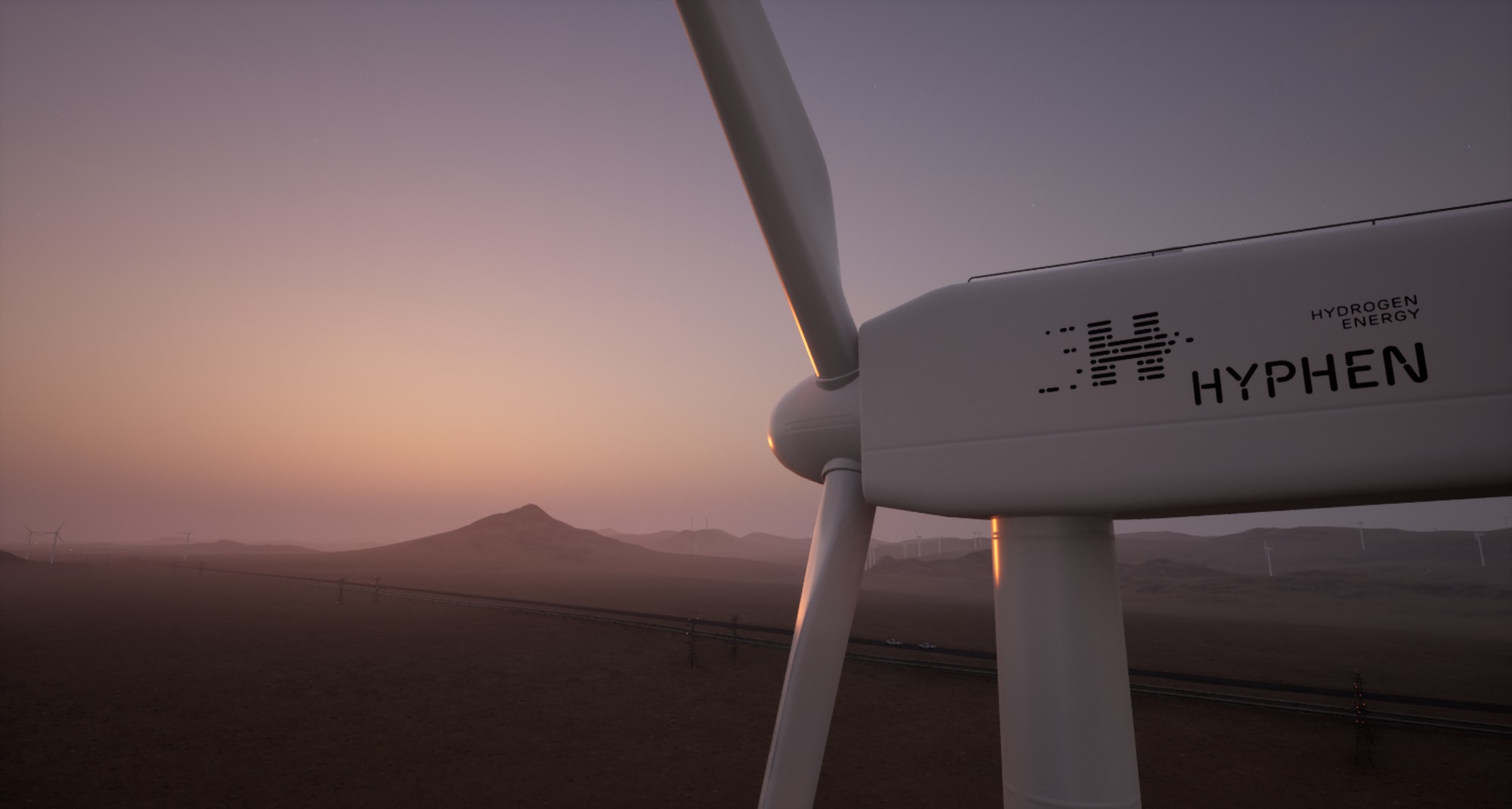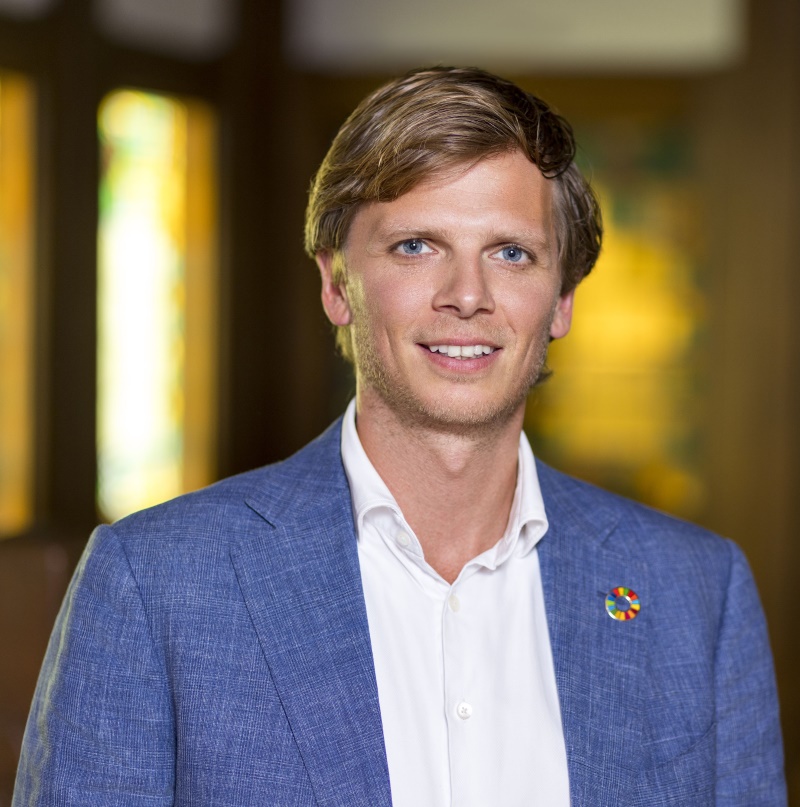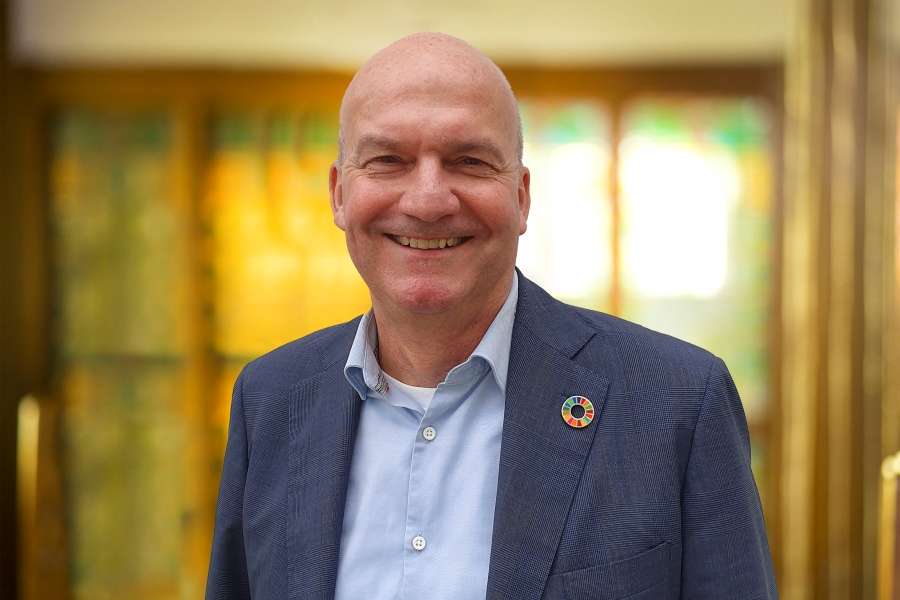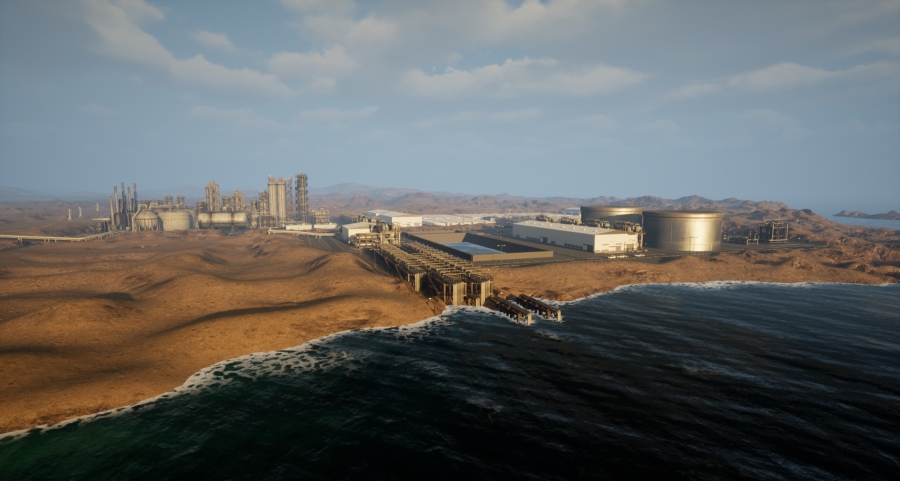Can you start by telling us about your background and how you got involved with Climate Fund Managers?
Sebastian Surie: I am Head of Green Hydrogen at Climate Fund Managers (CFM), a climate-focused blended-finance investment manager operating across Africa, Asia, and Latin America. My background is in private equity and project finance, and I have been with CFM since its establishment in 2015. I have lived and worked in Africa for many years, with my career centred around investments in infrastructure, particularly in renewable energy, water, and now green hydrogen.
CFM was founded as a joint initiative between the Dutch entrepreneurial development bank FMO and Sanlam Infraworks, a South African institutional investor, with the aim of creating climate-centric infrastructure investments. I played a part in establishing our first renewable energy fund, then a water, waste, and sanitation fund, and now our green hydrogen fund, which is dedicated to supporting the energy transition in emerging markets.
Green hydrogen is a particularly exciting space right now. It offers a pathway to decarbonise not only energy systems but also hard-to-abate sectors such as steel production, fertiliser, cement, methanol, and synthetic fuels for aviation. The role that CFM plays is not just to make these projects possible, but also to unlock them by ensuring they are investable and scalable across regions where access to large capital might otherwise be limited.
Willem, could you tell us about your role and how you collaborate with Sebastian at CFM?
Willem Frens: My role is to provide technical expertise on hydrogen and its derivatives for projects that CFM is developing in Southern Africa, particularly in Namibia and South Africa. I advise CFM on hydrogen and hydrogen derivatives like ammonia/fertiliser, direct reduced iron (DRI), and synthetic fuels. Additionally, I advise on the optimal use of locally produced green hydrogen within local existing or new industrial plants. Sebastian and his team manage the financial side, while I contribute my technical perspective on how to best execute the projects from a hydrogen production standpoint.
We have been collaborating for some time now on large-scale green hydrogen projects. While my focus is more on the technical viability, including safety aspects, technology choices, and risk management, I work hand-in-hand with Sebastian’s team to ensure that the projects are both technically sound and economically attractive to investors.
The promise of emerging markets
Why do you believe emerging markets like Namibia and South Africa are promising for green hydrogen development?
Sebastian Surie: Emerging markets, especially countries like Namibia and South Africa, hold enormous potential for green hydrogen production because they have the essential ingredients: vast renewable energy resources, plenty of land, and supportive government policies. Namibia, for instance, has huge expanses of land with some of the best solar and wind resources in the world, allowing for large-scale hydrogen production at very competitive prices.
Green hydrogen is well-suited to regions like these because it allows them to develop local green industries while also serving export markets. Europe, Japan, and South Korea, for example, are seeking to import green ammonia, a green hydrogen derivative.
South Africa is a bit more industrialised, and there is already an appetite for hydrogen from local industries, such as in the production of green steel, sustainable aviation fuels, and fertilisers. Additionally, South Africa’s position as a global supplier of platinum group metals is important for electrolyser technology, especially for PEM electrolysers, which require iridium, a by-product of platinum mining. This provides added synergies between green hydrogen production and the country’s existing industrial base.
What about the local workforce and industrial expertise in these regions? Do you believe they are prepared for such large-scale green hydrogen projects?
Sebastian Surie: Absolutely. In South Africa, for instance, you have a long history of large-scale infrastructure and industrial projects, particularly in energy and mining. That means there is a skilled workforce, experienced in large project development and management. This extends to the engineering companies and construction firms that will play a big role in building hydrogen (and derivative) plants, electrolysers, and the associated infrastructure.
Namibia may be less industrialised compared to South Africa, but the desire to upskill is significant. The country welcomes foreign direct investment and the participation of foreign industrials, which bring along much-needed skills transfer to the local market. Educational institutions, supported by both local and international stakeholders, are rapidly developing programmes aimed at training the next generation of workers in the renewable energy and hydrogen sectors. In fact, we see local governments working closely with universities to build educational curriculums around green hydrogen, which will be crucial in providing a long-term, sustainable workforce for the projects we are developing.
How can green hydrogen production impact the local economy in these emerging markets?
Sebastian Surie: Beyond the technical aspects, the economic potential for emerging markets is significant. By developing green hydrogen production, these countries are creating entirely new industries that not only provide jobs but also attract foreign investment. In Namibia, for instance, we are working to ensure that not all of the renewable energy and water produced is used for green hydrogen but will partly be fed into the local grid or used locally. Moreover, it is envisaged that part of the green molecules will end up in the local economy, fuelling industries like green fertiliser production or even electricity generation for remote areas. This localisation adds a layer of resilience to the country’s economy and helps reduce its reliance on imports.
In South Africa, the potential for green hydrogen goes even further. The country is a major player in mining and the chemicals industry, both of which are energy-intensive and emissions-heavy. By integrating hydrogen into sectors like steel production, we can help decarbonise key industries that are essential to South Africa’s economy while simultaneously creating new market opportunities for green products.
From a technical perspective, how do you ensure that projects in these markets meet international standards for efficiency and safety?
Willem Frens: Ensuring that the projects meet international standards is a top priority, especially when you are working in markets where there might be less experience with hydrogen technologies. We work closely with both local and international technology licensors and EPC contractors to make sure that everything, from the electrolysers to the transport infrastructure, is built to the highest standards.
Safety is also a critical factor. Hydrogen, while a clean energy carrier and feedstock to produce fuels and chemicals, has specific risks when it comes to storage, transportation, and handling. To mitigate these risks, we implement the best available safety technologies and ensure that facility designs incorporate redundancy and fail-safes for emergencies. These are non-negotiable for us. Hydrogen’s future success depends on it being produced, transported, and utilised safely. If we want the market to grow and public trust to follow, these standards are absolutely essential.
Technical and infrastructure challenges
What are some of the technical considerations when developing green hydrogen projects in these regions?
Sebastian Surie: When we assess a green hydrogen project, several technical aspects need to be carefully considered. First and foremost is the availability of renewable energy – both solar and wind – which is abundant in Namibia and South Africa. The cost, reliability, and availability of renewable energy are the primary factors influencing the overall cost of green hydrogen. Namibia, for example, offers some of the lowest cost solar in the world due to its geographic location.
We also need to think about water availability. Electrolysis requires a steady supply of water. In a place like Namibia, which is arid, this can be a challenge. However, desalination of seawater is a practical solution that can be adopted and aligns well with Namibia’s coastal geography.
Another major consideration is the infrastructure for transporting hydrogen and its derivatives to markets. Hydrogen itself is difficult to transport due to its low density, so converting it into ammonia or hydrogen-based products like green fertilisers or green steel makes transport easier and more practical. This means the projects we are working on need to be close to infrastructure, such as ports, that can handle the transport of ammonia and related products for export. The infrastructure is just as important as the hydrogen production process itself – if not more so – because it ultimately determines how scalable and economically viable a project is.
Willem Frens: Finally, the choice of electrolyser technology, as well as the downstream plants, play a significant role. Right now, we are working with a range of electrolyser technologies including PEM, alkaline, and potentially SOEC in the future. Each of these technologies has its own advantages. PEM electrolysers, for instance, are well-suited for regions with intermittent renewable energy supply because they can handle fluctuations in electricity. Alkaline electrolysers, on the other hand, are more established and tend to have lower capital costs. SOEC is emerging as a promising technology due to its higher efficiency, but it is still early in its commercialisation phase.
Can you explain the significance of these large-scale projects in the context of the global green hydrogen economy?
Sebastian Surie: These large-scale projects are incredibly significant because they have the potential to supply hydrogen and its derivatives at a volume that can impact global markets. For instance, the project we are working on in Namibia – Hyphen – is expected to be one of the world’s largest green hydrogen developments.
Green hydrogen is key to decarbonising industrial sectors that are difficult to electrify, like steel and ammonia production. If you look at the global steel industry, for example, it is one of the largest emitters of carbon dioxide. By replacing the carbon-intensive processes used in traditional steel production with hydrogen-based processes like direct reduced iron (DRI), we can make significant progress towards reducing global emissions.
Additionally, the hydrogen produced at this scale allows us to drive down costs over time, making it more competitive with grey hydrogen (produced from natural gas). The economies of scale that come with these projects are critical to achieving that cost parity.
Financing green hydrogen projects with blended finance
CFM uses a blended finance model. Could you explain how this works and why it is particularly suited for green hydrogen projects?
Sebastian Surie: Blended finance is one of the most important mechanisms we use to bring these green hydrogen projects to life, particularly in emerging markets. The concept behind blended finance is that we combine different sources of capital – donor funding, capital from development finance institutions (DFIs), and institutional investors – into a single fund. Each source of capital has its own risk and return profile, which allows us to use the donor capital to take on the highest risk during the early stages of a project, such as during feasibility studies or securing permits, and bring in more commercial capital at a later stage in the project lifecycle.
Green hydrogen is still an emerging sector, and projects are capital-intensive, which makes it difficult to attract purely commercial investment early on. By using donor capital to absorb the early risks, we make the projects more attractive to institutional investors once they have been de-risked. These institutional investors come in later, once the project has reached what we call an ‘investable’ stage, typically at start of construction. This model allows us to mobilise significant amounts of capital that might otherwise be difficult to raise.
For green hydrogen projects, this is particularly important because the technology, while proven, still requires large upfront investments and long lead times before projects start generating cash flows. By using blended finance, we are able to unlock that initial capital and move projects forward to the point where they can attract more conventional sources of funding.
From a technical standpoint, how does CFM ensure that these projects are built with long-term sustainability in mind?
Willem Frens: Sustainability is not just about producing hydrogen but also about ensuring that the entire project lifecycle is environmentally and socially responsible. One way we ensure sustainability is by carefully selecting technologies that are efficient and have a minimal environmental footprint.
In addition, we are designing these projects with scalability in mind. We want to make sure that as demand for green hydrogen grows, the projects can be expanded to meet that demand without having to overhaul the entire system. This means building flexible infrastructure, such as modular electrolysers that can be added as needed.
Sebastian Surie: We are also committed to ensuring that the projects benefit local communities. For example, we are working with local governments to create training programmes that will provide the skills needed for jobs in the green hydrogen sector. This is not only good for the local economy but also ensures that the projects have a sustainable workforce over the long term.
Hyphen and other projects
Can you provide some examples of projects you are currently working on?
Sebastian Surie: One of our largest projects is the Hyphen hydrogen project in Namibia, set to produce green hydrogen and ammonia for export using Namibia’s extensive renewable resources. This project has the potential to be a game-changer for the region.
“The Hyphen project has the potential to be a game-changer for the region.”
— Sebastian Surie
We also recently signed a funding agreement with HyIron to develop Africa’s first green iron plant that will use green hydrogen.
HyIron: developing Africa’s first climate-neutral iron plant
HyIron is developing Africa’s first climate-neutral iron plant, the Oshivela project, in Namibia’s Erongo Region. This groundbreaking initiative will help decarbonise the notoriously hard-to-abate iron and steel sector, which accounts for 9% of global greenhouse gas emissions. Traditional iron production relies on fossil fuels such as coal or natural gas, resulting in significant carbon emissions that are hard to reduce due to the need of carbon-based energy carriers for the reduction of iron ore in conventional steelmaking.
HyIron addresses this challenge by using green hydrogen, produced from renewable energy, as a reducing agent instead of carbon. In this process, green hydrogen reacts with iron ore in a rotary kiln, producing direct reduced iron (DRI) with water as the only by-product. This breakthrough technology enables the production of DRI with virtually no CO₂ emissions.
HyIron is a partnership between Namibian and German renewable energy and engineering companies. The Oshivela project builds on a successful pilot HyIron conducted in Germany in 2022. Phase 1 of the project commenced construction in November 2023. The site is expected to be commissioned in Q4 2024, with an annual output of 15,000 tonnes of green DRI, avoiding 27,000 tonnes of CO₂ emissions per year – equivalent to 50% of Namibia’s power industry emissions.
Phases 2 and 3 will expand production to 200,000 tonnes and two million tonnes of green DRI per year. The project will create 900 permanent jobs and 6,000 construction jobs, driving socio-economic growth and reinforcing Namibia’s position as a global green hydrogen hub.
The second and third phases are co-funded by SDG Namibia One, a USD 1 billion target green hydrogen facility dedicated to incubating Namibia’s green hydrogen sector and related infrastructure. The facility is managed by Nam-H2 Fund Managers, a joint venture between Climate Fund Managers, the Environmental Investment Fund of Namibia, and Invest International.
In South Africa, we are working on several initiatives, including projects focused on green steel and green ammonia production, as well as building the infrastructure to support these industries. We are also exploring opportunities to produce green fertilisers and synthetic fuels. These projects are still in the development phase, but they have enormous potential to decarbonise key sectors of the South African economy.
We want to ensure that these projects not only contribute to the global energy transition but also provide tangible benefits to the local economy and communities, in terms of job creation and economic development.
The role of policy and partnerships
What role do governments and policy frameworks play in the success of these projects?
Sebastian Surie: Government support is absolutely critical for the success of green hydrogen projects, particularly in emerging markets. In Namibia and South Africa, we have seen strong support from local governments, both in terms of policy and financial incentives. This has been key to attracting investors and getting projects off the ground.
In Namibia, for example, the government has been very proactive in creating a regulatory framework that supports green hydrogen development. This includes offering land concessions for renewable energy projects and providing incentives for companies that want to invest in the hydrogen sector. Similarly, in South Africa, the government has launched several initiatives to promote the development of green hydrogen, including public-private partnerships and financial support for research and development.
At the international level, we are also seeing growing support for green hydrogen from organisations like the European Union, which has committed significant funding to hydrogen projects as part of its Green Deal. Green hydrogen is not yet competitive with its grey counterpart, and the sector requires government stimulus through more formalised incentive programmes (e.g., subsidy schemes, grants, tax-incentives) to unlock long-term offtake contracts. In addition, certification schemes defining what qualifies as ‘green hydrogen’ are still under development. Therefore, critical government stimulus is still required to unlock this nascent sector.
How important are partnerships with local and international stakeholders for the success of these projects?
Willem Frens: Partnerships are critical – no single organisation can develop these projects on their own, given the complexity and scale involved. We work closely with local governments, international donors, technology providers, and project developers to ensure that we have the right mix of expertise and resources.
“Partnerships are critical – no single organisation can develop these projects on their own.”
— Willem Frens
Outlook and advice for developers
What is your vision for the future of green hydrogen in emerging markets over the next decade?
Sebastian Surie: I believe that green hydrogen will play a transformative role in the global energy landscape, and emerging markets like Namibia and South Africa will be at the forefront of this revolution. With the right investments, partnerships, and policies, these countries can become major players in the green hydrogen economy, supplying both local industries and export markets. Our goal at CFM is to be a catalyst for this change, helping to unlock the full potential of green hydrogen in the global south.
Over the next decade, we will see significant growth in the green hydrogen sector, both to meet the growing demand for green energy solutions as well as to cater to hard-to-abate industries that need a green molecule to decarbonise. Finally, we expect an industrial shift to the global south, whereby certain industries, such as steel, chemicals, fertilisers and synthetic fuels, are likely to move closer to the source, i.e., where green hydrogen is produced most competitively, and an industrial shift towards emerging markets.
What advice would you give to project developers looking to attract investment for green hydrogen projects?
Sebastian Surie: My advice is to start with the end in mind. Think about your off-take agreements and how you plan to access markets. It is essential to identify where the demand for green hydrogen or its derivatives will come from and build your project around that. Whether it is for green steel, fertilisers, or synthetic fuels, having a clear end market will make your project more appealing to investors.
“Start with the end in mind. Think about your off-take agreements and how you plan to access markets.”
— Sebastian Surie
Another key factor is building strong partnerships. Whether it is with local governments, technology providers, or international donors, having the right partners in place can make all the difference. Finally, make sure your project is sustainable – not just environmentally, but also socially and economically. Investors are increasingly looking for projects that have a positive socio-economic impact, so it is important to factor that into your planning from the start.
“Make sure your project is sustainable – not just environmentally, but also socially and economically.”
— Sebastian Surie





